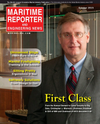
Page 14: of Maritime Reporter Magazine (October 2015)
Marine Design Annual
Read this page in Pdf, Flash or Html5 edition of October 2015 Maritime Reporter Magazine
SOFTWARE SOLUTIONS
Making Sense and Taking Risks
Human Behavior in the Shipping Industry
BY MATTI BARGEFRIED
The guide helps to identify counter- we give to it. This process is in? uenced lost per year, according to Lloyd’s Reg- sense-making was wrong as well as the measures to avoid human errors and bad by a number of things, most importantly ister, and between 1995 and 2007 this communicational behavior of the crew.
decisions. Discover how to manage the culture, experience, social needs and amounted to 160 million gt. human element on all levels – from the character. As in the of? ce ashore, the The guide continues with a case study The Problem with Making Sense engine room, to the bridge, to the shore. manager’s door might be open to wel- for sense-making: speci? cally that of a As we can understand from the ex-
From our summary of “The Human El- come everyone or it might be open in or- U.S. Coast Guard training cutter being ample, the patterns and situations that ement – A Guide to Human Behavior in der to spy on his underlings. How do you rammed in 1978 by a vessel four times create a problem primarily exist in the the Shipping Industry,” we examine the judge? It is one situation, but according the cutter’s size. (See story below “US- heads of people, hence they are unique. chapters “Making Sense of Things” and to your perception of the person’s char- CGC Cuyahoga: The Last Voyage) Regulators today tend to close the ex- “Risk Taking,” breaking down the most acter and attributes and to your experi- How did it happen? It happened when posed gaps with stricter regulation and relevant information. Dirk Gregory and ence in other companies, your judgment the captain of the Coast Guard vessel no- new technical procedures. Therefore the
Paul Shanahan of the UK Maritime and alters. ticed an approaching ship. Both vessels rule books grow bigger, creating uncer-
Coastguard Agency developed the origi- To share the sense that we make of in- were running at full speed and quickly tainty and greater complexity. At the nal guide. formation, we need empathy and com- closed up to each other. The captain saw same time, people become lulled into munication skills; otherwise, we will not only two signal lights on the vessel, and a false sense of safety provided by the
Making Sense of Things be able to transfer reason and meaning. therefore assumed that it was heading in technical crutches. The guide quotes:
People are surrounded by vast amounts However, even when we can transfer the same direction as he was. His crew- “Automation creates new human weak- of information and need to make sense this successfully, we might have been members saw three signal lights and nesses…and ampli? es existing ones,” of it all. We need that information to betrayed by our own minds and chosen knew the ship was coming towards them, reminding us that humans need to keep support our goals and plans, as they can- the wrong thing to transfer. Our minds but did not attempt to communicate this, pace.
not withstand a changing world without are picky; they like to ? nd evidence that as it seemed obvious. Meanwhile, the adapting to the current situation. Never- supports our current assumptions and captain rationalized to himself the fast- Risk Taking theless, before we can use information to decisions. Sense-making plays a vital closing speed (as seen on the radar) with In the last part, we learned that people modify our plans, we need to choose the role in almost all shipping accidents. the simultaneous overtaking of a ? shing have to make sense of things (informa- information to process and the sense that On average there are 182 large vessels boat. Eleven men died. The captain’s tion) in order to make decisions or plans.
USCGC CUYAHOGA: The Last Voyage
At about 2100 hours on 20 October 1978, in an area about 3.5 miles northwest of Smith Point, which marks the mouth of the Potomac River as it empties in the Chesapeake Bay, catastrophe occurred.
The Argentine coal freighter Santa Cruz II, a 521-foot bulk carrier, hit the Cuyhoga on her starboard side between amidships and the stern. A consensus of accounts indicated that the cutter was dragged backwards for a minute and then fell away from the tanker, rolled on her side, and sank within a couple of minutes. The
Santa Cruz rescued 18 survivors from the water and stayed on the scene until help arrived. The remain- ing 11 men embarked on the Cuyhoga were lost. Four days after the accident, a Marine Board of Inquiry convened in Baltimore, Maryland, at the Marine Safety Of? ce to investigate the accident.
After some delay due to heavy seas and high winds, two massive ? oating cranes were used to raise the
Cuyhoga, which was in 57 feet of water. After an initial inspection, the ship was placed on barges and towed 65 miles to Portsmouth for a full inspection.
The Marine Casualty Report, number USCG 16732 / 92368 and dated 31 July 1979, concluded:
The Commandant has determined that the proximate cause of the casualty was that the commanding of? cer of the USCGC CUYAHOGA failed to properly identify the navigation lights displayed by the
M/V SANTA CRUZ II. As a result he did not comprehend that the vessels were in a meeting situation, and altered the CUYAHOGA’s course to port taking his vessel into the path of the SANTA CRUZ II. The
Cuyahoga was later sunk off the coast of Virginia as an arti? cial reef.
(Source: US Coast Guard)
Photos: U.S. Coast Guard 14 Maritime Reporter & Engineering News • OCTOBER 2015
MR #10 (10-17).indd 14 10/2/2015 9:59:59 AM

 13
13

 15
15
